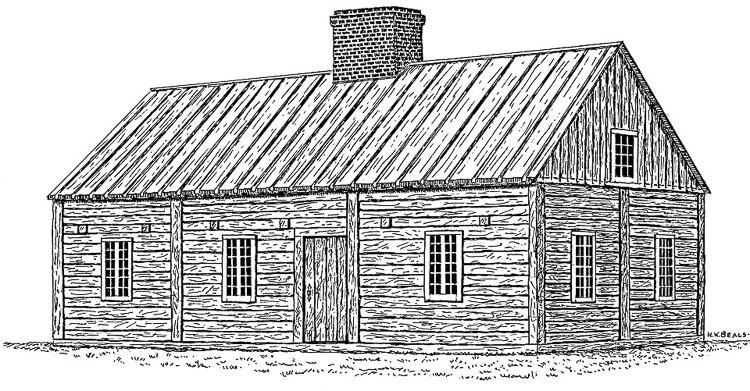
The public is invited to visit and talk with student and professional archaeologists during the excavation Tuesday through Saturday, 9 a.m. to 3 p.m.
This summer, a team of students and professional archaeologists from Portland State University, Washington State University, and the National Park Service (NPS) are exploring the site of the Fort Vancouver school, where the children of fur trade families studied in the early 1800s. Archaeological excavations will take place from July 1 to July 30. Excavation sites will be located north of East 5th Street and inside the Fort Vancouver stockade. The public is invited to visit and talk with student and professional archaeologists during the excavation Tuesday through Saturday, 9 a.m. to 3 p.m.
“The former site of the Hudson’s Bay Company’s schoolhouses is one of the most important but little-known places in Fort Vancouver,” said National Park Service Regional Archaeologist Dr. Doug Wilson. “Education at Fort Vancouver was progressive in some ways but also designed to ‘civilize’ children that came from mixed and Indigenous backgrounds.”
This excavation is part of Fort Vancouver National Historic Site’s Public Archaeology Field School Program, a long-running partnership between the NPS Regional Office, Fort Vancouver National Historic Site, and local universities that allows students to learn archaeological field techniques in one of the most important sites in the Pacific Northwest. This year, while learning field and laboratory methods, field school students will rediscover places tied to the education of the Indigenous and Métis (Indigenous and European heritage) children of the fur trade.
One of the structures studied this summer also served as the “Owhyhee Church” for Native Hawaiian workers of the Hudson’s Bay Company as well as being the location of the first (1838) Roman Catholic mass in the Pacific Northwest. Students and archaeologists will explore places tied to education and the religions that were dominant at Fort Vancouver during the early colonial era. Students will examine the belongings of past people associated with Fort Vancouver to re-examine the history of these important and contested colonial places.
“Many children attended the school here,” said Portland State University Archaeologist and Field Director Katie Wynia. “Some of them had good experiences, and some did not. We are excited to share the stories of the school and its students and teachers with the public at this dig site. Visitors to the site will be able to see history as it is uncovered and learn about the science of archaeology.”
The Fort Vancouver school formed part of the Hudson’s Bay Company’s colonial project to “civilize” and assimilate Native American and Métis children who were either children of fur trade families or orphaned as a result of disease epidemics. It represents the first boarding school for mixed and Indigenous children. Starting with John Ball, a Dartmouth alumnus who taught for a season in 1832, there were several schoolmasters of uneven quality. The schoolhouse structure, a repurposed kitchen, was also used by Native Hawaiian lay preacher William Kaulehelehe as both a residence and a place to teach other Hawaiians employed by the fur trade company. Click here to learn more about school at Fort Vancouver.
The field school will employ scientific methods to collect artifacts and data from the Schoolhouse/Owhyhee Church site and to locate the later New Schoolhouse sites. Washington State University archaeologist Dr. Colin Grier and his students are collecting information using Ground Penetrating Radar to guide the excavations. It is hoped that this project will shine a light on the history of education in the Pacific Northwest and address how objects of the past help us understand the present.
In addition to the archaeological excavation, ranger-led programs will share the story of the Fort Vancouver school with the public. Through the month of July, these walking tours will take place on Wednesdays, Fridays, and Saturdays at 10 am. Participants will walk through the fort with a park ranger while hearing stories of the teachers who taught here and their students. The tour will end at the dig site. Reservations are not required. Tours will begin inside the reconstructed Fort Vancouver, located at 1001 E 5th Street, Vancouver, WA 98661.
What: The 2022 Public Archaeology Field School at Fort Vancouver National Historic Site.
Who: Hosted by the National Park Service with partners at Washington State University Vancouver and Portland State University.
Where: Inside the reconstructed Fort Vancouver and in the Great Meadow area north of E 5th Street.
When: July 1-30, 2022. The public is invited to visit the excavation Tuesday through Saturday, 9 a.m. to 3 p.m. Ranger-led tours will take place on Wednesdays, Fridays, and Saturdays at 10 a.m. through the month of July.
Information provided by Fort Vancouver National Historic Site.
Also read:
- Vancouver mayor pro tem acknowledges the mayor ‘set the trap’ for Michelle BelkotAudio reveals Vancouver mayor pro tem described mayor’s plan to provoke Belkot at C-TRAN meeting, sparking removal and lawsuits.
- Opinion: An unacceptable tax burdenNancy Churchill outlines new tax proposals in Washington state, warning of growing burdens on working families amid budget shortfalls and government overspending.
- Expect delays on eastbound SR 14 West Camas Slough Bridge for annual inspection, SaturdayAnnual inspection will close the eastbound lane of SR 14 in Camas.
- Vancouver Police investigate shootingVancouver Police investigate a carnival shooting involving youth and a firearm.
- POLL: Is it time for new leadership at Vancouver City Hall?A new weekly poll asks whether Vancouver voters should prioritize replacing the mayor and city council in the 2025 election.
- Opinion: How will the majority party’s new budget and tax proposals affect you?Rep. John Ley critiques the state’s proposed 2025-27 budgets, warning of record-breaking tax hikes and economic impacts.
- Opinion: Washington’s EV sales far short of next year’s state mandateTodd Myers highlights how Washington’s EV sales fall short of next year’s mandate, raising concerns over rising car prices and limited options.











